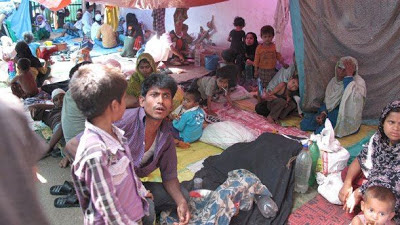Who are these Rohingyas? Are they Burmese? But then they cannot speak the national language of Burma, so how can they be Burmese?
Who are the Bangladeshi immigrants in India's North East Region? Are they Indian?
The Rohingyas are Bangladeshis and are Bangali speaking Muslims from Bangladesh who are illegal infiltrators in Myanmar!
Rohingyas are illegal immigrants from Bangladesh into Rakhine State and self-claimed as one of Myanmar Ethnics. Now they attack on natives and threatening Myanmar's Governance in the area, they want Rohingya Islamist Territory.
The native ethnic people (Arakanese) have to run for lives from Rohingya Terrorists' attack and insecure now, begin in own land and being threatened by Rohingyas.
The Rohingyas and their Bangali Bangladeshis are creating law and order problems in India's North East Region also, which is similar to the conflict in Arakan.
This is not Religion conflict. This is not Human Right violations.
There is a similarity between the Rohingya Problem of Myanmar & The Bangladeshi Infiltration Problem in India’s North East Region, the common link is that these are both from Bangladesh!
Immigration of Bangali Muslims during the British Imperial Rule from the province of East Bengal (later East Pakistan and now Bangladesh) to the neighboring regions ( India’s East and Myanmar’s West ) has been a ongoing process to this day, and has assumed alarming proportion threatening to drive the Indigenous tribes to extinction.
India has had successive immigration from what is now Bangladesh, in 1947 during the communal partition of India, then in 1971 when Bangladeshi was established and till this date Bangladeshis continue to infiltrate into India’s East!
While the Myanmar Govt is serious to stop the Rohingya onslaught of the indigenous lands the situation in India is reverse as the politicians thrive on minority appeasement policy and the Bangladeshi illegals have now emerged kingmakers in Assam.
How Muslims lied to the world about "Buddhists killing Muslims in Myanmar"
Exposed : How Muslims are lying about Burma's Muslim Killings on Social Media ...
By Faraz Ahmed ( Pakistan )
http://blogs.tribune.com.pk/story/12867/social-media-is-lying-to-you-about-burmas-muslim-cleansing/
---------
---------
Pakistan / Porkistan / Pokistan / Napakistan / Dajjalistan / Mother & Father of Terrorism / Killer of fellow Muslims like Ugyurs, Baloch, Balwaristani, Ahmadiyas & Shias / Persecuting its own Hindu & Christians / Liars spreading false propaganda that Burma Buddhists are killing Muslims!
Thieves & Liars shouting Thief Thief!!!What a shit land! Pakiland!
.... And the Rohingyas are now in India!!! ( From Burma to Bangladesh and now finally to India )
Photo : Rohingya's in New Delhi’s exclusive Visant Vihar locality.....
A Burmese viewpoint on Rohingyas : By Aung Thu Hein
There is no Rohingya in the Myanmar history; the name Rohingya was “invented” as if it should have existed in time immemorial to be valid; Rohingyas are culturally and religiously different illegal immigrants from Bangladesh who are cheating the history to claim the land of Arakan; and Rohingyas (or Bangali-Muslim-Kalars) are threatening to take over Burma.
The intense campaign against Rohingyas shows that minority people supposedly the victims of oppression are willing to enact oppression on another oppressed group.
First, U Tin Oo, vice-Chairman of National League for Democracy, said in a weekly interview program with Radio Free Asia (Burmese Section) on his experience as an army commander under Ne Win’s government that Rohingyas are immigrants from Bangladesh and that he helped protect ethnic Arakans from Rohingya threats.
Second, Maung Maung Than, Director General of Immigration and National Registration told BBC Burmese in regard to the repatriation of nearly 30,000 Rohingya refugees from Bangladesh that Burma has no ethnic group called Rohingya.
In early October, Arakan political groups organized events denouncing the Rohingyas’ use of the name “Arakan”. These events have renewed an intense campaign against ethnic Rohingya.
Rohingya is national security issue for Myanmar. It is all about defending Myanmar identity, religion, culture and ethnicity. I am Ok with anyone to be Myanmar citizen as long as they obey its laws, accept existing culture, respect existing religion, and live peacefully.
Rohingya will never do a single thing I mentioned. They will not obey Myanmar laws and will only obey to Islam Law, will not accept Myanmar culture and not only follow their own culture, but also try to destroy existing one, will not respect Buddhism and try to destroy it and will not live peacefully and try to ask for their own autonomy and untimately secession from Myanmar.
I am amused when I see that of all countries India, that has already suffered a disastorous partition after the British exit & is reeling under Bangali illegal infiltration from Bangladesh is aiding in settlement of Rohingyas in Indian states.
While India's own indegenious Cashmeeri Hindus roam like refugees.
The Indians are either too innocent that they dont know the evil designs of the cunning Rohingyas or are too stupid and are ignoring the Rohingya threat in the wake of hollow secularism.
India & its coming generations will regret the descion to embrace Rohingyas as the Rohingyas will not only transform Indian cities into large diseased slum colonies but will also put the Indian economy to tatters by sucking India's resources.
Aung Thu Hein
Description of Bangladeshi illegal infiltration in Myanmar’s Rakhine province by a Burmese
Thief shouting Thief!
By Sidney N
The Rohingyas ( Bengali speaking Muslims of Bangladesh ) come in illegally on their own will and then they claim they have been terrorized on our land. And they want to make the world known.
Look at this face in the picture.
Myanmar people do not have faces that look like this.
This is the face of a Bengali.
And this is what these Rohingya people, as what they like to call themselves look like.
If you are suffering in Myanmar, look for other land. Myanmar has hosted so many of you for a long time. You are not the victims, the people who are terrorized by your acts and moving away to avoid violence are the victims.
Our western state is called the Rakhine State. The Rakhine people are Buddhist majority and a few Christians. No Rakhine is a Muslim.
The state borders Bangladesh and divided by 3 rivers than run north to south parallel.
The Naaf River separates our Rakhine State from Bangladesh. Some highlands run the length of the Naaf River from our side making a natural barrier to the frequent cyclones and push them back into Bangladesh and thus they suffer yearly, making their land useless with brackish water. They don't even have good drinking water.
And they fuck and multiply like rabbits because they believe this is their god given task in life to spread their religion.
Many want to come on our side because our grass is greener. And they do. They come in droves, whole boat loads of them, dark skinned, bearded, wiry old men with several wives and a herd of naked children. Most of them can't afford to wear clothes don't wear any or partially clothed, until they are about 3-4 years old.
When they are on our side, they don't want to be one of us. The stick to their own communities, mosques and don't speak any of our 8 languages.
They only want to establish a whole new race on our land.
These Bangalis are now a major population along the stretch of the two sides of the highlands between the Naaf River and the second river further inland, the Kaladan River. On this stretch of our land they number more than 75% and the Rakhine people, our ethnic race are less than 25% population.
We don't want them to come further inland after the Kaladan River.
The western world want us to give them access to come inland and start fucking like rabbits and populate our land like an infectious disease.
Year after year, they terrorize our Rakhine villages, take the women away and mutilate the men by cutting their ears or noses. Every year there is a secret day called the Rakhine Killing Day.
Trouble in Mumbai over Rohingya & Bangladeshi problem
Radical Muslim Organizations create law & order problems in Mumbai in support of Bangladeshis in Assam & Rohingya illegals in Myanmar...
The so called 'peaceful' rally in Azad Maidan organized by Raza Academy, an organisation working to promote Islamic culture, the protest was supported by other organisations like Sunni Jamaitul Ulma and Jamate Raza-e-Mustafa, turned violent & out of control!
The demonstrators started torching vehicles, damaging buses, shouting slogans, and indulging in stone pelting prompting the police to fire in the air.
-------
Clearly, The Radical Muslim organizations want to paint a communal colour to the situation in Assam by terming the conflict as Hindus Vs Muslim rather than Bodos Vs Bangladeshi illegals!!!
Also what is their biz to create problems because of Rohingyas, Bangali illegals in Myanmar! Why are they making it India's problem! We have nothing to do with Rohingya's.
If these facists have the guts they should challenge the Myanmar millitary govt that will make them shit in their pants & make these Jehadis eat shit!
Bloody rascist Jehadis!!!
Mumbai Azad Maidan riot losses at Rs 3cr
The Mumbai crime branch probing the August 11 Azad Maidan violence that left two dead and 63 injured, has made a fresh list of the losses incurred in the riot, which now total around Rs 2.7 crore.
The police are likely to submit the list to the Mumbai collector, seeking to recover the losses, said sources.
"Many vehicle owners, particularly bikers, are still coming up to claim losses they suffered in the riot.
Initially, they did not turn up for the fear of being caught but now as days are passing, they are approaching us, and clarifying their stand,'' said an officer.
Sources said that by next month, the police would forward the list of losses to the collector who, in turn, would issue orders directing the rally organizers to pay for these.
Raza Academy, Madina Tul-Ilm, other NGOs and community leaders who sponsored the rally would be made to pay, they added.
---------
3 crore is a very small amount compared to the damages & shameful acts that the mob committed.
Considering the misuse of democratic society the troublemakers were let off easily.
It would have set an example if the organizers, organizations and participants of the mob must be blacklisted & their activities monitored by law and order agencies!!
Extracts from the letter by VHP ( Viśva Hindu Pariṣad ) to Indian PM, UN asking to deport Jehadi Rohingya Muslims from Delhi to Bangladesh
1. Approximately 3000+ Rohingya Muslims infiltrated from Bangla Desh border & reached up to India’s capital New Delhi have parked themselves – men, women, children etc. – in various areas in & around New Delhi. Before we get into the basic question that how such a large number of infiltrating groups could even enter India’s border & reach nation’s capital, I wish to inform you that this large group of Rohingya Muslims has been creating danger & dirt for the residents of New Delhi especially near the UNHCR office in Vasant Vihar, demanding Refugee Status from the UN.
2. After much complaining & our peaceful intervention, these Rohingya Muslims have been now sheltered in the Mosques in the villages near Vasant Vihar area of New Delhi where the UNHCR office is located. They have been sheltered there by the Ex Vice Chancellor of Jamia Milia Islamic University Mr. Nawab Zafar Jung who also happens to be now a sitting member of the Government of India’s Monitoring Committee for Minority Education.
3. Holding a Govt post & yet helping the illegal infiltrators not only reach New Delhi all the way from the Bangla Desh – Myanmar border, but also sheltering them in the mosques nearby despite complaints by the local residents, is a completely anti-national activity by a Govt Committee member.
4. For your ready reference: Rohingya Muslims is the community that is born of Burmese (Myanmar) mothers & Bangla Desh Muslim Fathers & the community follows Islam. Staying in Arakan area at the border of Bangla Desh & Myanmar, they are internationally known for the massacres & ethnic cleansing of Buddhists (Chakma Buddhists & others) that Rohingya Muslims did just 10-15 years back.
5. Some of the survived Buddhists are still staying in the worse human conditions in India that is Bharat in Tripura & surrounding areas. Rohingyas are also known for killing thousands of people from Jumma Tribe in their area.
6. Rohingya Muslims, the way they have suddenly popped up in New Delhi with the help of local Muslims in Bharat, also tried to infiltrate Thailand & create terror there. Thailand has therefore banned the entry of Rohingya Muslims. (Reference: Attached Appendix)
7. More so, as the said Rohingya Muslims have a track record of Jehadi Terrorism, not just in their own area that is a Arakan at Bangla Desh – Myanmar border, but also in Afghanistan, on Russia Border, Thailand & Saudi Arabia etc. (Please refer to the attached Appendix Number 1: Bin Laden & Rohingya Muslims – Weekly Blitz, Appendix 2: Paper – Suicide Jihadi Terrorism in Bangla Desh- by Shri B. Raman, Additional Secretary (Retd.), Cabinet Secretariat, Govt of India & Director, Institute for Tropical Studies, Chennai & other attached documents)
8. The above documents by the authentic sources clearly prove that the Rohingya Muslims are directly involved in Jehadi Terror activities independently & also through their Terror outfit RSO (Rohingya Solidarity Organization). The above documents mentioned in my point number 7 also prove in no uncertain terms the serious links of Rohingya Muslims with HUJI, Al Qaeda, ISI, LET & other Jehadi operatives in Pakistan, Bangla Desh, Afghanistan & more importantly, in Jammu & Kashmir.
9. American Govt has issued a serious Jehadi Threat alert about the Rohingya Muslim community recently & also declared them terrorists since they fought hand in hand with Talibans in Afghanistan on the border of Russia during Afghanistan – Russia war. (Apart from the above ref documents: See Appendix 3: Bangla Desh- Breeding Ground for Terror – Asia Times printed interview of American Govt & Military officials – CNN) This clearly mentions specific Rohingya Muslims as Jehadi terror group having links with most Jehadi operatives for current & active Jehad.
10. There are over 40+ Lakh (4 Million) Rohingya Muslims in the world. They are spread as follows:
(a) Burma : 20 Lakh (2 M)
(b) Bangla Desh : 6 Lakhs (0.6 M)
(c) Pakistan: 3.5 Lakh (0.35 M)
(d) Saudi Arabia: 4 Lakh (0.4 M)
(e) Thailand: 1 Lakh (0.1 M)
11. Rohingya Muslims’ mother country Myanmar, with the new democratic rule there now, has asked them to get out due to their Jehadi activities & mainly because of their war against Myanmar for creating a separate Islamic State – Arakan.
12. After using Rohingya Muslims for spreading Jehadi terror all over the world, in Myanmar & in Bharat, now Bangla Desh has realized that globally Rohingya Muslims are now exposed in Jehadi Terror & creating a separate state dividing Bangla Desh, now their father’s country Bangla Desh also is chasing them out.
13. After trying to settle in Thailand etc & being shunned everywhere because of Jehadi Terror links, now the Rohingya Muslims have fixed their eyes on India that is Bharat. Therefore, over 3000+ of them have parked themselves in & around capital New Delhi demanding Refugee Status by the UN.
14. With men, women, children (2 women even delivered kids in Delhi recently!), these Rohingya Muslims are now playing a diplomatic Jehadi war against Bharat by pushing the UN to give them Refugee status. This means that Bharat will never be then able to ask them to leave Bharat irrespective of their Jehadi Terror links or activities. At this moment only 3000+ Rohingya Muslims are seen in Delhi, but the way they entered Bharat all the way from Bangla Desh border, proves that they have strong support from either the Jehadi groups in Bharat or/ and by the Govts. Otherwise without any interruption, such a large group of infiltrators known for Jehad would have never reached New Delhi. And after reaching there, would not have been sheltered, supported & lobbied for by the Govt committee member.
15. The Rohingya Muslims, well taken care of by such groups & a few students unions in Delhi have been doing international Public Relations & lobbying projecting them as ‘victims’ of bangle Desh’s tyranny & therefore getting Refugee Status to force Govt of India to give them shelter, food, education, jobs & then citizenship to their kids. At this moment, even though only 3000+ are seen in Delhi, they either may be hiding all over India or waiting to hoard immediately in India once they get the Refugee status.
16. As the Rohingya Muslims are responsible for the massacre & ethnic cleansing of the peace loving Buddhists like Chakma Buddhists etc in the Arakan area near India border, any effort of Govt of India to help Rohingya Muslims will permanently spoil Indi’s relations with all Buddhists & Buddhist nations hurting over 100 Crore (1000 Million) Buddhists & more than that Hindus globally & in India!
Our Urgent Demands:
1. Rohingya Muslims are known & proven Jehadi Terrorists condemned by & currently alerted about by the American & European Govts, Russian Govt & by the international terrorism research groups & institutions. Sheltering them in India means sheltering Jehadi Terror. We demand that the Govt of India immediately deport them from where they came without any further delay.
2. There should be a blanket ban on the entry of the Rohingya Muslims into India from any border or by any means.
3. Govt of India should write to the United Nations & to UNHCR (United Nations High Commissioner for Refugees) in New York & in New Delhi NOT to give them any status (Refugee, Asylum Seeker or any such) ever.
4. As Rohingya Muslims are directly involved in the HUJI, IM, Pakistan’s ISI & other such Jehadi linked terror in Jammu & Kashmir as well as on the borders, those who helped them enter India, travel through various Indian states up till Delhi, gave them shelter & other help should immediately prosecuted for Treason & under all prevailing anti Terror laws.
Page 4
1. Once it is found out exactly who are the people & institutions have been helping Jehadi Terror Group Rohingya Muslims, in India, such institutions should be banned & people running them should be prosecuted.
2. India that is Bharat already has been facing various Jehadi terror threats. Despite international terror alert about Rohingya Muslims, if Govt of India does not take immediate actions against them, then this would clearly mean a political decision to support Jehadi terror group. This will put Bharat’s safety & security in danger.
3. Considering the relations of India with America & Russia, sheltering the Rohingya Muslims despite these countries warning about them will permanently spoil India’s diplomatic relations with them. Therefore, Govt of India should take help from America & Russia to prevail on the UN for not giving Refugee status to Rohingya Muslims.
4. This is an urgent matter as the Rohingya Muslims have been bragging that on May 15, 2012 they will get the Refugee status by the UN. Therefore, if the Govt of India is truly serious about the war against terror as it keeps on saying on various forums, then leaving aside the slow Govt processes, every step should be taken to stop the UN from giving Refugee status to the Rohingya Muslims as it will not only harm the majority of Bharat but will lead to the second partition as well as destruction of resources of Bharat with over 40 Lakh (4 Million) Rohingya Muslims putting their additional load on India with their Jehadi terror links!
Dhanyavaad & hoping for a quick & concrete action against Rohingya Muslims
Sincerely
Dr Pravin Togadia
Finally, To know more on the Rohingya & Bangladeshi problem please support the Facebook page - The Rohingya Problem
Page Link - https://www.facebook.com/rohingyaproblem
The Rohingya Probem in Myanmar is the same as Bangladeshi Problem in India!
Page Link - https://www.facebook.com/rohingyaproblem
The Rohingya Probem in Myanmar is the same as Bangladeshi Problem in India!
Please join and support the Anti-Bangladeshi infiltration into India and Myanmar.
The newly launched Facebook page that will focus on the twin related issues of illegal immigration from Bangladesh to India & Myanmar.
This page is managed by Bloggers / Writers from Myanmar and India informing about the Bangladeshi Rohingya related issue from India & Myanmar.


